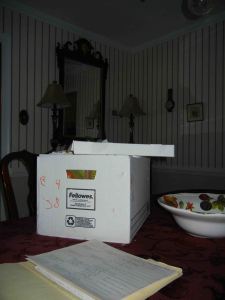After Grandma Springer’s final letter, my youthful interest in genealogy waned. My family tree along with its family data sheets and Grandma Springer’s letters were packed away in a cardboard box for more than three decades. After locating the box in May 2013, I re-read Grandma Springer’s letters.
Grandma Springer’s letters contained teasers – little pieces of bigger stories begging to be discovered. I began “thinking outside the box” that held everything I knew about my ancestors. I envisioned myself sitting at the computer and effortlessly accessing all this and more with a few keystrokes and mouse clicks. I wanted to discover and tell my ancestors’ stories.
I began exploring websites offering free resources for people conducting online genealogical research. Some of the websites were:
- Cyndi’s List – a free website with links to lots of other genealogy websites
- Family Search – a free website with historical records from all over the world
- Find a Grave – a free website with memorials for graves all over the world, which are posted by volunteer contributors
- Geni – a free website for creating a collaborative, online family tree
- The USGenWeb Project – a free website with links to state and county websites created and maintained by volunteers with an interest in local history and genealogy
I created my first online family tree at Geni. The premise of Geni is sharing the work of building a family tree among many contributors. My mother, an uncle, and a few cousins joined Geni and helped build our first online family tree.
One of my second cousins encouraged me to consider Ancestry.com, where he had been building a family tree. Initially I was reluctant to pay for a service I could get for free. Eventually I joined Ancestry.com for a 14-day free trial and found it better met my needs than the free websites. Here are some of the reasons why I continue to pay for a membership to Ancestry.com two years and four months into this journey:
- New family trees are easy to create and build. A member can create and manage multiple family trees.
- Hints provide links to historical records that can be saved to family trees.
- A profile is automatically created for each person in a family tree. A profile chronicles the life of an individual and includes links to the supporting historical records.
- By default, family trees are public, but they can be made private. Members can view other members’ public trees.
- Guests can be invited to view family trees without having to pay a membership fee. There are options for guests to contribute information and view living people, but these features are not enabled by default.
- There are options for other members to contribute information and view living people, but these features are not enabled by default.
- New historical records are added on a regular basis.
- Online family trees can be synced to Family Tree Maker software installed on a computer. Family Tree Maker includes a good selection of templates for printing reports and charts.
- Family trees can be exported for creating backups and sharing.
Soon after joining Ancestry.com I realized there is a lot of conflicting information in members’ public trees. The root cause of the inconsistencies can sometimes be traced to errors in official records. Birth records, pension records, census records, cemetery records, and obituaries all contain errors. There are even incorrect dates etched in tombstones!
When I first encountered errors in official records, I remember being abhorred that official records contained errors. Whenever possible, I try to find two or three sources for each fact. I seek to understand and document why discrepancies may have occurred among the records. I found it helpful to understand a few of the reasons why official records sometimes contain errors:
- Many of the errors are simply mistakes. One of my uncles was omitted from the 1940 census. My cousins and I joke about him napping while the census taker was visiting Opa and Oma’s home and Oma forgetting about him.
- Spellings of names were sometimes a best guess. In the 1800s there were people who couldn’t spell their own names. Census takers guessed at the spelling or spelled names phonetically.
- People lied to census takers. In the 1900s, divorced women with children sometimes stated they were widows to avoid the stigma associated with being divorced. Women occasionally subtracted a few years from their real age.
- As people aged, they had difficulty recalling exact dates. Throughout the 1800s most state governments did not have laws requiring births, marriages, and deaths to be reported to the state or local government. Without modern record keeping tools, it was harder for people to keep track of important dates.
Unfortunately for Springer families, there is also a bogus Springer genealogy that was fabricated in the 1800s. That, my friends, is a story for another day.


Very interesting discussion of the advantages of Ancestry.com. I started entering my family data into familysearch.org but that programmed was discontinued a few years ago and I switched to Ancestral Quest. I haven’t yet figured out how to print the charts I want from this program. I’ll read your post again to find out which program you use. Thanks for the info.
LikeLike
I found another reason for misinformation in records for my family. On some death certificates it says who filled in the information and from my family knowledge I know that that person didn’t have the best information for whatever reason. A lot depends of the knowledge the person who fills out a form has.
LikeLike